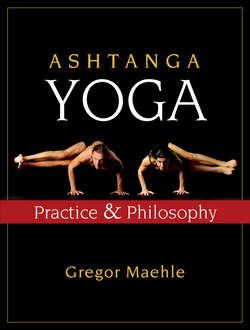Читать книгу Ashtanga Yoga - Gregor Maehle - Страница 16
На сайте Литреса книга снята с продажи.
Why a Traditional Practice is Still Applicable
ОглавлениеA peasant once spoke to the sage Ramakrishna thus: “I am a simple villager. Please give me in one sentence a method by which I can obtain happiness.” Ramakrishna’s answer was: “Totally accept the fact that you are a machine operated upon by God.” This needs to be deeply understood. It is through the belief that individuals exercise free will that ego is produced; and, in turn, ego produces suffering. In the Bhagavad Gita Lord Krishna states, “All actions are done in all cases by the gunas (qualities) of prakrti (nature). He whose mind is deluded through egoism thinks I am the doer.”10
This means that the entire cosmos, including our body-mind complex, is an unconscious machine operated upon by God. Our self, who is pure consciousness, is forever inactive. It merely witnesses. The giving up of the idea that it is we who act is echoed in the Yoga Sutra by Patanjali’s use of the term kaivalya. This final state of yoga is the realization of the complete independence of consciousness. Since it is completely independent, it has no way of influencing the world. Like a mirror, which simply reflects, consciousness can neither reject nor hold on to objects of its choice. Give up the sense of agency,11 says Krishna: “Only a fool believes I am the doer.”
The surrender of the illusion of free will is reflected in the vinyasa system by acceptance of the original system as expounded by the Rishi Vamana. Of course it is easy to make up our own sequences of asanas, and possibly commercial success and fame will result. But then we run the risk of falling for the ego, which says I am the doer and the creator. We are only pure consciousness — the seer, the witness, the self — which, as the Samkhya Karika12 says, plays no active part in this world.
That does not mean we cannot adapt the practice for some time if difficulties are to be met or yoga therapy needs to be practiced. We need to return to the original system whenever possible, though. Rishi Vamana’s system leads through outer structure and limitation to inner freedom. If we constantly practice self-made sequences, we create inner limitation through outer freedom.
The rishis of old did not conceive the ancient arts and sciences by trial and error. The method they employed was samyama, which combines concentration (dharana), meditation (dhyana), and absorption (samadhi). In that way, deep knowledge of how things really are can be gained. Patanjali himself explains in the Yoga Sutra how he gained his knowledge. Knowledge of the mind, he says, is gained by doing samyama on the heart.13
He also explains how the body can be understood. Medical knowledge, he says,14 is gained by practicing samyama on the navel chakra. This is how the science of Ayurveda came into being. It should be noted that Patanjali compiled the Charaka Samhita, an ayurvedic text. When we study and practice the ancient sciences today, we need to do this with a feeling of respect and devotion.
The teachings of the ancient masters have never been declared invalid. They have only ever been added to.
1. Krishnamacharya the Purnacharya, Krishnamacharya Yoga Mandiram, Chennai.
2. The Yoga Journal, San Francisco, November/December 1995.
3. Bhagavad Gita III.7.
4. Bhagavad Gita III.24.
5. Yoga Sutra II.12.
6. Maitri Upanishad VI.35.
7. Vijnanabhairava, trans. and annot. Jaideva Singh, Motilal Banarsidass, Delhi, 1979, p. 23.
8. Yoga Sutra I.41.
9. Yoga Sutra I.43, quoted from The Yoga Sutras of Patanjali, trans. C. Chapple, Sri Satguru Publications, Delhi, 1990, p. 53.
10. Srimad Bhagavad Gita, trans. Sw. Vireswarananda, Sri Ramakrishna Math, Madras, p. 79.
11. Frequently used in Indian texts, this word means “the condition of being in action or exercising power.”
12. A text describing Samkhya, the ancient prototype of all Indian philosophies.
13. Yoga Sutra III.34.
14. Yoga Sutra III.29.
